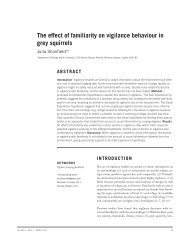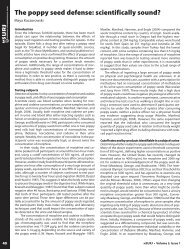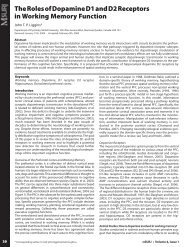the entire issue - McGill Science Undergraduate Research Journal ...
the entire issue - McGill Science Undergraduate Research Journal ...
the entire issue - McGill Science Undergraduate Research Journal ...
Create successful ePaper yourself
Turn your PDF publications into a flip-book with our unique Google optimized e-Paper software.
Maya Kaczorowski<br />
Figure 1: The Sieve of Eratos<strong>the</strong>nes<br />
Figure 2: Short proof of <strong>the</strong> infinitude of prime numbers<br />
Euler also developed <strong>the</strong> zeta function, relating a sum<br />
of fractions to a product of prime numbers, shown in Figure<br />
3. Bernhard Riemann extended it into what is now known<br />
as <strong>the</strong> Riemann Zeta function (Ivic, 2003). In 1859 Riemann<br />
published his results and hypo<strong>the</strong>sized that a function that<br />
has a zero root uniquely defines a prime number. Recently,<br />
in 2004, Gourdon and Sebah verified <strong>the</strong> Riemann hypo<strong>the</strong>sis<br />
for <strong>the</strong> first 10 trillion zeroes (Crandall and Pomerance,<br />
2005); never<strong>the</strong>less, <strong>the</strong> hypo<strong>the</strong>sis remains unproven.<br />
The discovery of prime numbers is simplified by computer<br />
programs, where <strong>the</strong> main challenge is finding a more<br />
rapid algorithm. Computer algorithms are usually compared<br />
using runtime analysis, which determines <strong>the</strong> worse<br />
case runtime given an input of length n. The runtime of a<br />
program is a function of <strong>the</strong> length of <strong>the</strong> input, and can be<br />
a polynomial, logarithmic or exponential equation. As <strong>the</strong><br />
input size increases, an exponential runtime will always be<br />
longer than a polynomial runtime, which in turn will be longer<br />
than a logarithmic runtime.<br />
The Sieve of Eratos<strong>the</strong>nes is an exponential algorithm to<br />
find prime numbers, which renders it ineffective in finding<br />
exceptionally large prime numbers. Since Eratos<strong>the</strong>nes, all<br />
deterministic algorithms to find primes have been exponential,<br />
so it was remarkable when a relatively simple deterministic<br />
polynomial algorithm was finally discovered in 2002 by<br />
Agrawal, Kayal and Saxena (AKS). The AKS algorithm, based<br />
on Fermat’s Little Theorem and o<strong>the</strong>r proven ma<strong>the</strong>matical<br />
assumptions, is an improvement but may still have an extremely<br />
long runtime, rendering it impractical. The search for an<br />
expeditious yet deterministic formula to find prime numbers<br />
is still underway, and <strong>the</strong>re is no doubt that computers will<br />
continue to provide ma<strong>the</strong>maticians with <strong>the</strong> ability to make<br />
fur<strong>the</strong>r improvements.<br />
Figure 1: The Riemann-Zeta function<br />
The use of prime numbers in Cryptography and <strong>the</strong> consequences<br />
of a deterministic formula for finding prime numbers<br />
Cryptography, <strong>the</strong> science of encrypting and decrypting messages<br />
for transmission between a sender and an intended recipient,<br />
may at first glance seem unrelated to <strong>the</strong> discovery of<br />
prime numbers. Beginning in Roman times, information was<br />
frequently encrypted using a private-key, meaning that <strong>the</strong><br />
sender and <strong>the</strong> recipient had to define a decryption codec that<br />
would allow <strong>the</strong> recipient to decode <strong>the</strong> message. This practice<br />
became impractical as technology evolved, since <strong>the</strong>re was often<br />
no secure way to communicate <strong>the</strong> private-key, especially<br />
over considerable distances. To deal with <strong>the</strong>se challenges,<br />
public-key cryptography was developed. Presently, <strong>the</strong> most<br />
common encryption methods in use rely on <strong>the</strong> difficulty of<br />
efficiently finding prime numbers.<br />
Whereas prime numbers are known up to several thousands<br />
of digits, it is much harder to factor composite numbers<br />
with several thousands of digits, especially if <strong>the</strong>y are composed<br />
of large prime numbers; a deterministic exponential<br />
time algorithm could take centuries to factor <strong>the</strong> composite<br />
number. This is <strong>the</strong> basis of public-key cryptography using<br />
<strong>the</strong> RSA encryption method created in 1978 by Rivest, Shamir<br />
and Adleman. Two large prime numbers p and q decide a large<br />
composite number N=pq as well as <strong>the</strong> encryption key e<br />
using an equation. From p, q and e, <strong>the</strong> decryption key d is determined<br />
by <strong>the</strong> same equation. An individual who wants to<br />
receive information securely makes public N and e, allowing<br />
anyone to send <strong>the</strong>m <strong>the</strong> information. If <strong>the</strong> information is<br />
intercepted, <strong>the</strong>n knowledge of d, which can only be determined<br />
if p, q and e are known, is required for decryption. This<br />
means that in order to decrypt <strong>the</strong> intercepted information,<br />
<strong>the</strong> individual, who only knows N and e, must factor N back<br />
into p and q, which is a restrictively time consuming process.<br />
On <strong>the</strong> o<strong>the</strong>r hand, if prime numbers could be found quickly,<br />
<strong>the</strong>n composite numbers could be factored much more<br />
swiftly, and <strong>the</strong> RSA method would fail, rendering electronic<br />
public-key encryption insecure.<br />
A similar threat to secure encryption is quantum computing,<br />
which is based on <strong>the</strong> principle that quantum properties could<br />
be used to represent data and perform operations as a traditional<br />
computer does. If quantum computing evolves beyond <strong>the</strong> experimental<br />
stages where it currently is, it presents <strong>the</strong> possibility of performing<br />
computations in record time. The same algorithms could<br />
be used, but would be executed much faster. For example, while it<br />
may take centuries to break an RSA code using a traditional computer,<br />
a quantum computer could take just seconds or minutes.<br />
March 2009 • msurj.mcgill.ca<br />
37









